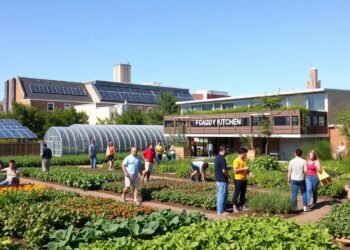How will the warming of our planet reshape the systems we all depend on, and what can the United States do now to reduce harm?
This Ultimate Guide explains how shifts in oceans, atmosphere, land, ice, and life create knock-on effects for communities, infrastructure, and ecosystems across the world.
Scientific monitors at NASA and NOAA give decision-ready data on rising sea level, falling Arctic ice, and growing emissions. These observations show the surface is roughly 1.2°C warmer than preindustrial times and that impacts like droughts, floods, fires, and biodiversity loss are already affecting people.
Over the coming time, policy choices and timely action will shape outcomes. This guide ties evidence to practical steps for mitigation and adaptation, focusing on U.S. leaders, planners, and informed readers who need clear, actionable direction.

Key Takeaways
- NASA and NOAA provide the data that grounds each section in verifiable science.
- Changes in one Earth system can trigger wide social and economic impacts.
- Emissions trends and policy choices determine future risks and costs.
- Impacts are uneven; some communities face higher risk and fewer resources.
- The guide links observed evidence to realistic mitigation and adaptation steps.
What Is Climate Change and Why It Matters Now
Slow, sustained warming now shapes the weather patterns communities rely on for water, crops, and infrastructure.
Define it: This phenomenon refers to lasting, large-scale shifts in baseline temperatures and weather over many years, not day-to-day variability.
Natural vs. human causes: Natural cycles—like solar variation or volcanic eruptions—affect the system, but scientific assessments show that since the Industrial Revolution, human activities have become the dominant cause.
How it works: Burning fossil fuels releases greenhouse gases that act like a blanket around the planet, trapping heat that would otherwise escape to space.
Major sources include energy, transport, buildings, industry, agriculture, and land use. Changes in averages also shift extremes, so heat waves, heavy rainfall, and droughts can become more frequent and intense.
Why now: Emissions accumulate over years, so delaying action locks in more warming. Early reductions lower risks, reduce adaptation costs, and keep more options open for U.S. communities—from coasts to farm belts—facing water and infrastructure impacts.
Long-term shifts in temperatures and weather patterns
These shifts unfold over decades and reshape long-standing seasonal norms.
Natural variability vs. human activities since the Industrial Revolution
Today’s trends reflect added heat-trapping gases from widespread fuel use, not just natural ups and downs.
The Evidence: A Warming World Seen from Space and on the Ground
Satellites and ground instruments now give a clear, linked record of warming across oceans, land, ice, and atmosphere. Those measurements make it possible to track how a warming world affects people, infrastructure, and ecosystems.
NASA’s Earth Science Division operates 20+ satellites that monitor oceans, land cover, ice, the atmosphere, and life. NOAA surface records and NASA’s GISTEMP show global temperatures have risen about 2°F (1.1°C) since 1850, with multiple decades marked by record warmth.
Sea level, ice, and greenhouse gases
Tide gauges and satellite altimetry report an 8–9 inch rise in global sea levels since 1880 and an accelerating rate that complicates coastal planning.
High-latitude indicators confirm warming: reference glaciers have lost mass for 36 straight years and Arctic sea ice has declined by roughly 31,100 square miles per year from 1979–2021.
Atmospheric measurements show carbon dioxide concentrations about 50% above preindustrial levels, reinforcing the greenhouse signal behind observed temperature trends.
Why multiple data streams matter
Independent datasets from NASA, NOAA, and international partners strengthen confidence in the trend and its drivers. Tools like GISTEMP and the Sea Level Change Team turn observations into decision-ready insights for states and local planners.
Small shifts in global averages cascade into larger extremes on the ground—from nuisance flooding to earlier spring thaw—so these indicators guide investments to reduce future risk.
Causes of Global Warming: Greenhouse Gases and Burning Fossil Fuels
Human activities over the last two centuries have driven a steady rise in greenhouse gases that trap heat in the lower atmosphere. Understanding these causes helps target policies that cut risk and deliver public benefits.
Carbon and methane sources in the U.S.
Major sectors include power generation, transport, buildings, industry, agriculture, and land-use change. These activities produce most emissions and reduce natural carbon sinks like forests.
Agriculture, oil and gas operations, and waste handling also release methane, a potent but shorter-lived gas. Targeting high-emitting sectors yields large near-term benefits for health and the economy.

How the greenhouse effect traps heat
Gases such as carbon dioxide and methane absorb outgoing infrared radiation and re‑emit it, warming the air near the surface. Burning coal, oil, and gas combines carbon with oxygen to make CO2 that accumulates over time.
CO2 persists for centuries, so cumulative emissions set long-term temperature outcomes. Feedbacks—like less ice reflection and warmer oceans that hold less carbon—can amplify warming, which is why cutting emissions at the source is the most direct fix.
Reducing emissions lowers health burdens from air pollution, spurs clean energy jobs, and protects infrastructure. Clear attribution of causes helps design standards, incentives, and investments that reduce risk across the United States.
Climate Change Impacts We’re Experiencing Today
Communities across the country see stronger storms, longer dry spells, and rising tides that affect homes and roads. These trends are not distant — they are affecting people now and reshape planning and budgets.
Heat waves, storms, drought, flooding, and wildfire risk
Heat waves occur more often because higher background temperatures make extreme warm spells more likely. That raises public health stresses and pushes electric grids during peak demand.
NOAA records show heavier downpours across most of the U.S., overwhelming drainage and causing flash floods and property loss. Warmer oceans fuel stronger, wetter hurricanes, which raise inland flooding and recovery costs.
In the West, multi‑year drought and higher air temperatures increase evaporation and crop water needs. Longer, dryer fire seasons and drier fuels heighten wildfire risk and produce smoke that degrades air quality across regions.
Rising seas and coastal hazards across U.S. communities
Global sea level has risen about 8–9 inches since 1880, which increases high‑tide flooding and magnifies storm surge impacts. Roads, ports, and housing face repeated disruptions as tides and storms combine.
These impacts hit hardest in places with fewer resources. Vulnerable people and communities struggle more to prepare, respond, and rebuild after extreme events.
Effects cascade: extreme heat can warp roads and rails, while floods close supply routes and hurt small businesses. These trends are happening now and will intensify without rapid emissions cuts and scaled adaptation. The next sections explore water, food, health, and infrastructure responses in detail.
Water, Weather, and the Changing Hydrologic Cycle
Water managers now confront more extreme variability. A warmer atmosphere holds more moisture, so storms dump heavier rain in many places while other regions dry out. These shifting patterns force new planning for supply and flood control.
Heavier precipitation events versus intensifying droughts
NOAA reports stronger, more frequent downpours across much of the U.S., even as droughts grow longer in the West. In the East and Midwest, stormier conditions overwhelm stormwater systems and increase runoff.
Meanwhile the West and Southwest face persistent dry spells that stress reservoirs, wells, and groundwater. Extreme swings—from very wet to very dry—complicate traditional water planning and raise flood and drought risk.
Snowpack decline, earlier snowmelt, and water scarcity
Rising temperatures drive earlier snowmelt and reduce April–June snow cover. That shift moves runoff away from summer peak demand for cities and farms.
Less reliable mountain snow affects reservoir operations, groundwater recharge, and competition among users. Upgrading stormwater systems, investing in reuse, modernizing irrigation, and integrated watershed planning help protect scarce resources.
Forecasting and early warning systems give utilities and emergency managers time to act. Protecting water underpins public health, food production, energy reliability, and resilient ecosystems as the nation adapts to ongoing climate change.
Food and Agriculture Under a Warming Climate
For many producers, hotter seasons and earlier snowmelt mean tighter water budgets and trickier planting windows.

Crop stress from heat, water shortages, and shifting seasons
Higher temperatures reduce yields for heat‑sensitive crops and shift flowering and harvest dates, raising pest and disease pressures.
Farms that once relied on predictable frost dates must now adjust planting and harvest timing to match new seasonal patterns.
Water, soils, and land management
Drought and earlier snowmelt strain water resources and force changes in crop choice, irrigation, and soil moisture management.
Growers invest in efficient irrigation, cover crops, and soil practices that retain moisture and protect productive land.
Health risks for people, workers, and animals
Rising heat raises risks for farmworkers—exhaustion and heatstroke—so shade, hydration, and altered schedules are essential.
Livestock face heat stress that lowers productivity and raises veterinary costs, creating on‑farm energy and input demands for cooling and care.
Resilience measures include drought‑tolerant varieties, precision agriculture, diversified rotations, windbreaks, and on‑farm solar and efficiency upgrades.
Federal and state programs, updated crop insurance, and data tools like seasonal forecasts and drought monitors help producers manage risk.
Supply chains also feel impacts: processing, storage, and transport must adapt to variable yields and timing as climate and change reshape markets.
Health, Ecosystems, and Ocean Impacts
More frequent hot days, worsening smoke, and shifting disease risks are creating new public‑health and ecosystem challenges across the United States.
Direct health effects include more dangerous heat days that raise heat‑stroke and cardiac risk. Wildfire smoke raises particulate exposure and can worsen asthma and other lung conditions. Severe storms also cause injuries and chemical hazards from damaged infrastructure.
Vector and air quality risks grow as minimum temperatures rise. Mosquitoes and ticks are moving into new regions, increasing the chance of Lyme, West Nile, and other infections. Heat combined with ozone formation also worsens respiratory illness.
Ecosystem timing and marine stress
Shifts in seasonal timing can leave plants blooming before pollinators arrive, reducing reproduction and harming biodiversity. Protecting habitats and restoring corridors helps species adapt.
Oceans absorb about 30% of emitted carbon dioxide, which drives acidification and weakens shells for shellfish and plankton vital to food webs. Marine heat waves trigger coral bleaching and, combined with stronger storms, physically damage reefs that support coastal life and economies.
Arctic warming and sea-level rise
The Arctic is warming at least twice as fast as the global average. Rapid ice loss from glaciers and ice sheets adds to global sea‑level rise and alters weather patterns far from the poles.
Preparedness matters. Public health steps—cooling centers, clean‑air shelters, disease surveillance, and targeted outreach—reduce harm. Conserving wetlands, expanding urban tree canopy, and protecting water quality keep fisheries, recreation, and drinking water healthier as temperatures continue to shift.
Infrastructure and Economic Risks in the United States
From power plants to ports, public and private assets are facing more frequent shocks that threaten service and budgets. Nearly 40% of U.S. residents live in coastal counties, so many communities see higher exposure as sea levels rise and storms intensify.
Strain on energy, transport, and digital systems
Extreme heat and peak demand push energy grids to their limits, creating higher operating costs and outages that affect households and businesses. This risk requires upgrades, storage, and flexible demand to keep power reliable.
Heavy rainfall and overwhelmed stormwater systems flood roads and disrupt freight, emergency response, and daily commutes. Bridges, airports, ports, and broadband nodes are vulnerable to flood, erosion, and heat‑related wear, which raises repair bills and delays goods movement.
Coastal hazards, planning horizons, and fiscal impacts
Rising seas make high‑tide flooding and storm surge damage more frequent, pushing utilities and streets into repeated repair cycles. Where protection is infeasible, managed retreat, buyouts, and nature‑based solutions become part of the toolbox to reduce exposure.
Long asset lifetimes mean today’s designs must account for future conditions to avoid locked‑in costs and stranded assets. Local budgets, insurance markets, and credit ratings reflect recurring shocks, often widening gaps for frontline communities with fewer resources.
Updated hydrology, sea‑level, and heat projections should guide codes, capital plans, and investment decisions so workforce continuity and supply chains stay resilient across regions.
What the Future Holds: Rates, Risks, and Timelines
Future warming will set the tempo for risks and costs communities face over coming decades.
Warming trajectories to mid-century and beyond
Different emissions pathways lead to very different outcomes by mid‑century. Thousands of scientists agree that limiting warming to 1.5°C avoids the worst impacts.
Under current policies, projections point toward roughly 3.1°C by 2100. Halving emissions by 2030 and reaching net‑zero by 2050 are key milestones that slow the warming climate and lower long‑term sea‑level rise.
Why every tenth of a degree matters for people and ecosystems
The rate at which temperatures rise shortens the time available to adapt. Faster warming compresses planning windows, strains infrastructure, and increases the chance that physical thresholds—like heat indices or design limits—are crossed more often.
Small increments matter: each tenth of a degree raises the frequency of extremes that drive economic losses and health harms. Because CO2 is long‑lived, early cuts buy more benefit than delayed ones.
Planning for uncertainty means using upper‑bound scenarios for critical systems, aligning capital investments and workforce training with shifting timelines, and adopting adaptive pathways that can scale as projections become clearer.
From Emissions to Solutions: Climate Action Paths
Rapid, coordinated action can halve emissions by 2030 and put the nation on track to net zero by 2050. That goal pairs mitigation with resilience investments so benefits reach workers and communities alike.
Cutting emissions by shifting energy systems
Switching from fossil fuels to renewables like solar and wind reduces carbon and lowers greenhouse gases from power and transport.
Priority steps include electrifying buildings and vehicles, modernizing grids, boosting efficiency, and cutting methane in oil, gas, and waste.
Adapting with resilience and early warning
Early warning systems and protective infrastructure save lives and property and often return many times the investment.
Upgrade drainage, harden critical facilities, restore natural buffers, and use nature‑based solutions to protect people and assets.
Financing, equity, and data‑driven decisions
Blend public and private resources, leverage federal programs, and design funding that reaches underserved communities.
Use NASA and NOAA tools—sea‑level scenarios, heat projections, wildfire data, and downscaled maps—to align plans with real risks and track progress.
Accountability matters: set 2030 and 2050 milestones, monitor emissions, and invest now. Rapid cuts reduce future adaptation costs and deliver jobs, cleaner air, and lower bills for people across the world.
Conclusion
Decisions made in this decade will determine how often heat, floods, and storms disrupt lives and infrastructure. The record shows roughly 2°F of warming since 1850, sea level up 8–9 inches, Arctic ice declining rapidly, glaciers losing mass for decades, and atmospheric carbon dioxide about 50% above preindustrial levels.
Those trends drive greater impacts on water, land, and daily life. Greenhouse emissions from fossil fuels remain the central cause, so rapid emissions cuts are essential to limit further warming and reduce future risk.
Near‑term priorities are clear: halve emissions by 2030, aim for net zero by 2050, invest in protective infrastructure, and scale early warning and preparedness. Use NASA and NOAA data to guide projects, track progress, and adapt as conditions evolve.
Translate insight into action—policy, finance, and community choices now deliver safer neighborhoods, resilient jobs, and healthier air for years to come.
FAQ
What is causing the recent rise in global temperatures?
The main driver is increased greenhouse gases from burning fossil fuels like coal, oil, and natural gas for energy, transport, and industry. These gases trap heat in the atmosphere, raising average temperatures worldwide and altering weather patterns, sea levels, and ice cover.
How do scientists know the world is warming?
Multiple lines of evidence confirm warming: satellite records from NASA, surface temperature networks, shrinking glaciers, earlier snowmelt, and rising sea levels. Decades of data show a clear upward trend in global average temperature and more frequent record-warm years.
What role does carbon dioxide play in warming?
Carbon dioxide is a long-lived greenhouse gas produced when fossil fuels and some land-use changes release stored carbon. Higher CO2 concentrations increase the greenhouse effect, trapping more heat and driving long-term warming and related impacts on ecosystems and weather.
Are extreme weather events linked to rising temperatures?
Yes. Warmer air and oceans fuel more intense heat waves, heavier precipitation events, and stronger storms. Changes in atmospheric circulation and moisture levels also increase risks of drought, flooding, and wildfire in different regions.
How does sea level rise affect coastal communities?
Melting ice sheets, glaciers, and thermal expansion of warming oceans raise sea levels, increasing high-tide flooding, storm surge damage, and shoreline erosion. Communities face higher costs for protection, relocation, and infrastructure repair.
What happens to freshwater supplies as temperatures rise?
Higher temperatures alter the hydrologic cycle: some regions get heavier precipitation while others see longer droughts. Reduced snowpack and earlier melt reduce summer streamflow, stressing water supplies for cities, farms, and ecosystems.
How will agriculture and food systems be affected?
Crops face heat stress, shifting growing seasons, and more variable water availability. Yields for heat-sensitive crops may decline in many regions, and farmworker and livestock health can suffer from increased heat exposure and extreme weather.
What health risks increase with warming?
Heat-related illness, worsened air quality from wildfires, and expanded ranges for vector-borne diseases (like West Nile or Lyme) are key risks. Vulnerable groups—elderly, children, and low-income communities—face greater impacts.
How do oceans respond to higher CO2 and temperatures?
Oceans absorb heat and CO2, causing warming, more intense marine heatwaves, coral bleaching, and acidification. These changes harm fisheries, biodiversity, and coastal livelihoods while altering ocean circulation patterns.
Can infrastructure handle ongoing changes in weather and sea level?
Many existing systems—roads, bridges, power grids, ports—were built for past conditions and are increasingly strained. Upgrades, resilient design, and planning for higher standards are needed to reduce disruption and economic losses.
What can communities do to adapt and reduce risks?
Communities can invest in early warning systems, protective infrastructure, nature-based solutions (like restored wetlands), and updated building codes. Local planning that accounts for future sea levels and extreme events improves safety and resilience.
How do we limit future warming and its impacts?
Rapidly cutting emissions by shifting from fossil fuels to renewable energy, improving efficiency, and reducing methane releases limits future warming. Policies, finance, and technology deployment at scale are essential for a just transition.
Are there tools to help policymakers and planners make informed choices?
Yes. Agencies like NASA and NOAA provide climate data, models, and decision-support tools that show projected temperature, sea level, and precipitation changes. These resources help target investments and prepare communities for future conditions.
Why does every fraction of a degree of warming matter?
Small differences in average temperature change the frequency and intensity of extreme events, sea level rise, and ecosystem responses. Limiting additional warming reduces risks to people, infrastructure, agriculture, and biodiversity.





